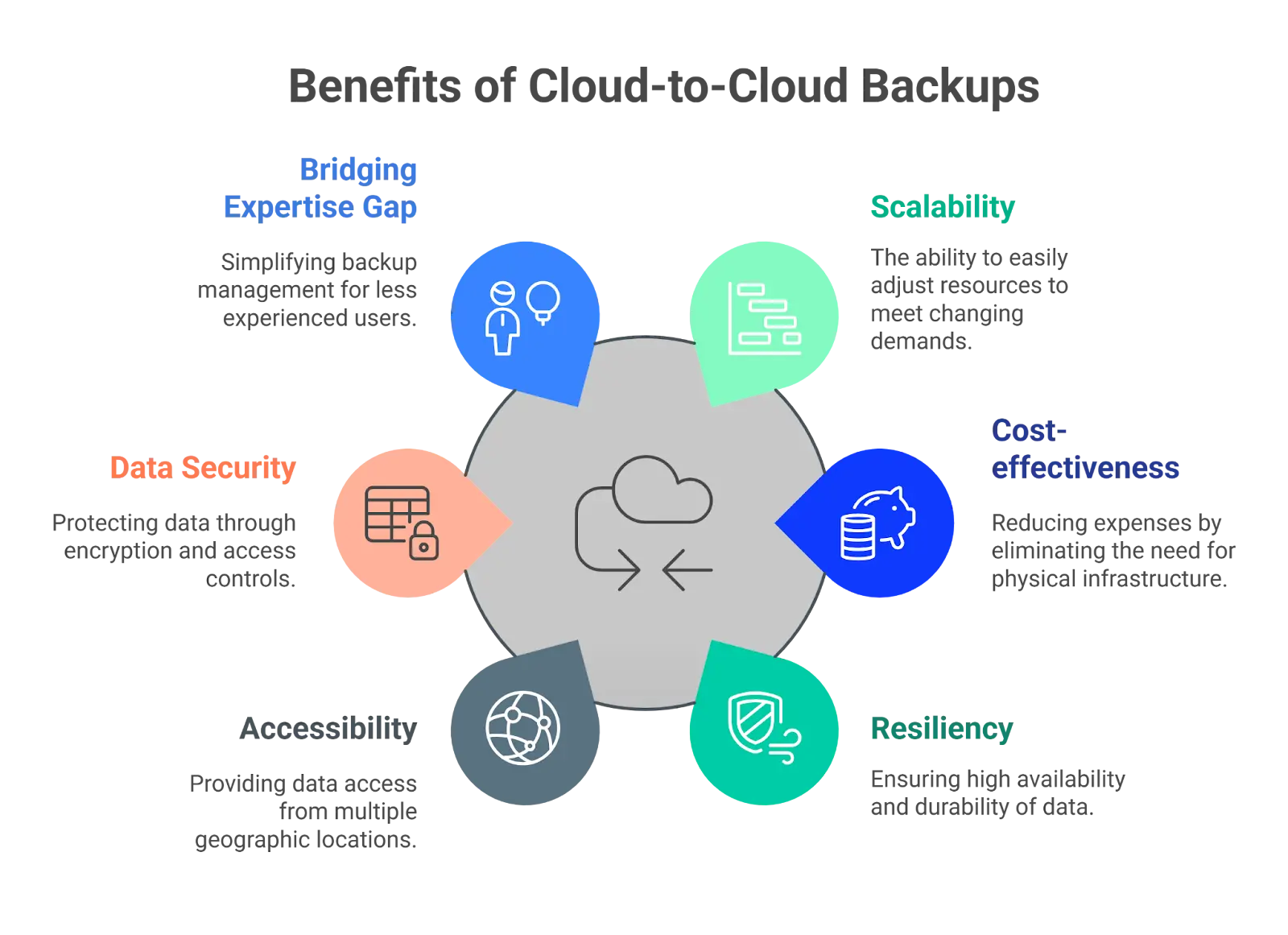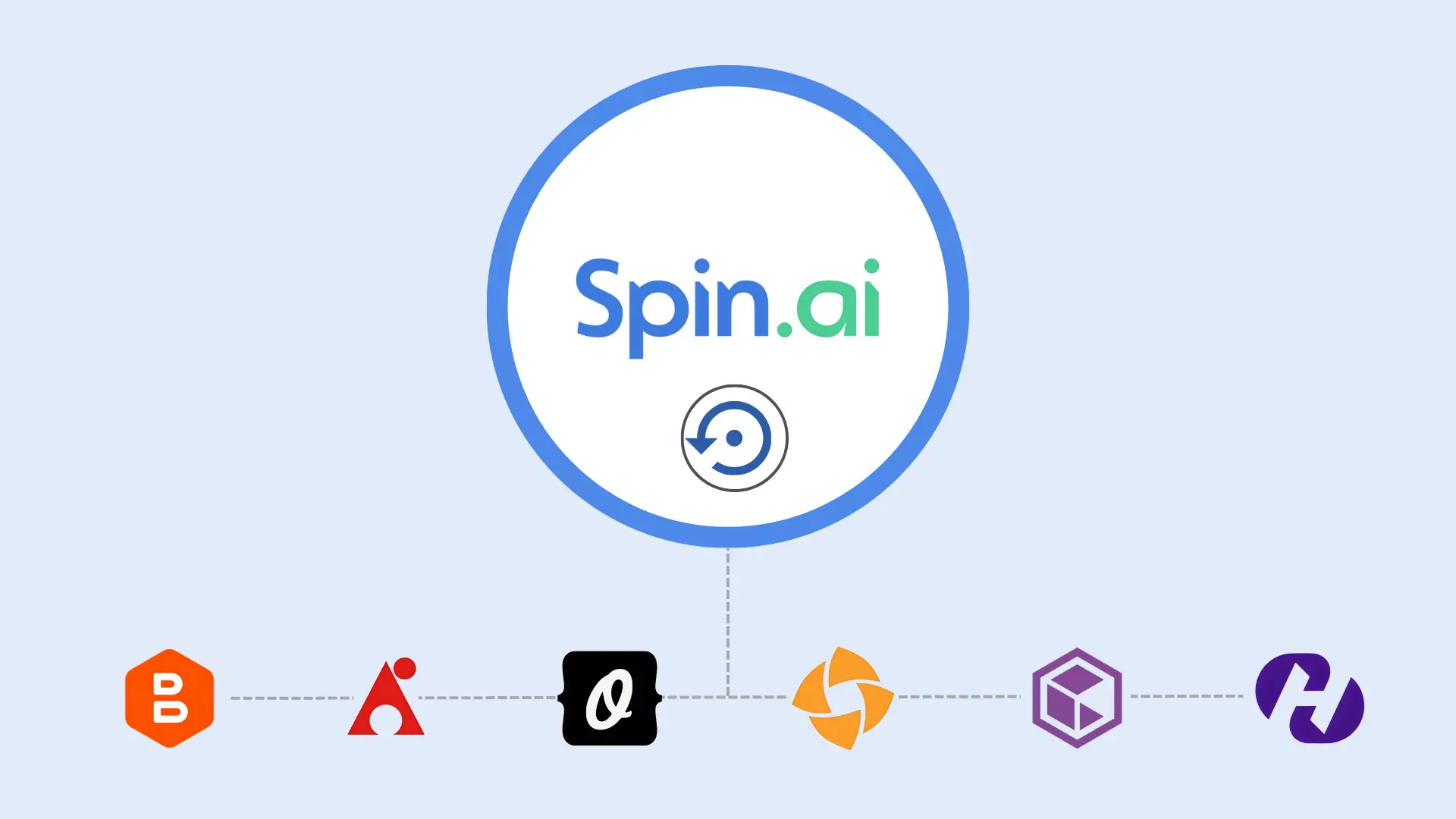What is Cloud to Cloud Backup and How Is It Different?
- Cloud-to-Cloud Backup Article Summary
- What is cloud-to-cloud Backup?
- Benefits of Cloud-to-Cloud Backups
- The Drawbacks of Cloud-to-Cloud Backups
- Why you need Cloud-to-Cloud Backups
- Cloud-to-Cloud Backups vs Traditional Backups
- List of Cloud-to-Cloud Backups Vendors
- Choosing a cloud-to-cloud Backup Solution
- Spin Backup Features
- FAQs
Cloud-to-Cloud Backup Article Summary
Cloud-to-cloud (C2C) backup refers to the practice of copying data from one cloud service to another, providing an added layer of protection for business-critical data stored in cloud environments like Google Workspace™ and Microsoft 365. As organizations increasingly rely on Software-as-a-Service (SaaS) applications, the need for C2C backups has become paramount. This solution helps mitigate risks associated with data loss, ensuring that businesses can quickly recover from errors or breaches.
C2C Backup Key Points:
- Definition: C2C backup allows data stored in one cloud service to be backed up to another, functioning as an off-site backup.
- Benefits:
- Protects against various data loss scenarios beyond the native backups of SaaS providers.
- Simplifies and speeds up the backup and recovery process.
- Enables global access to backed-up data.
- Provides protection against ransomware attacks due to separate storage environments.
- Drawbacks:
- Cost can rise with increased data volumes.
- Management of larger datasets may become complex.
- Comparison: C2C backups offer more comprehensive protection compared to traditional backup methods, especially for SaaS applications.
- Importance: Essential for business continuity, C2C backups ensure that organizations can recover data accurately in its last known state.
Vendors: Numerous specialized vendors exist that focus on C2C backup solutions tailored for various popular SaaS applications.
You and your business are now using the powerful world of cloud storage and cloud applications. Naturally, you show interest in the cloud-to-cloud (C2C) backup and try to understand the pros and cons of this venture for your business. Here, you will find out the answers to many questions about cloud backup. How can cloud-to-cloud backup save your business when using cloud environments? What is cloud-to-cloud backup? What are its advantages, how does it compare to other backups, and what is the best solution against data loss? Keep on reading.
What is cloud-to-cloud Backup?
Due to risks to your business-critical data housed in cloud environments like Google Workspace™ (formerly G Suite) and Microsoft 365 (formerly Office 365), backups are essential. Backups provide a protected copy of your data at a single point in time. This allows business-critical data to be restored in the event of data loss as a result of your end-users or security threats.
Cloud-to-cloud backup is a term used to refer to a cloud backup service that is housed in a cloud environment (Amazon AWS, Google GCP, Microsoft Azure, etc) that can take cloud-based backups of the data you have housed in the cloud.
Using today’s nomenclature, a cloud storage backup service is essentially a Backup-as-a-Service offering by a cloud backup vendor that can effectively snapshot your data and store it safely in the cloud so it can be restored if needed.
The proliferation of cloud backup technologies available today has resulted in the need to rethink your traditional backup strategies relying on on-premises backup solutions. With the explosion of data stored in the cloud, it makes more sense from an infrastructure and resources perspective to make use of backups that are also stored in the cloud.
Benefits of Cloud-to-Cloud Backups

Unlimited scalability
Cloud-to-cloud backup offerings are highly scalable, meaning they can adapt to changing workloads by scaling up or down in the quantity and variety of data, applications, and locations. Customers can easily get additional resources, storage, and features if necessary. Amazon Elastic Block Storage (EBS) is an excellent example of cloud storage that offers “scalability as a service” functionality. As stated by Amazon, EBS enables organizations to increase storage without any disruption to their critical workloads.
Cost-effectiveness
A major advantage of cloud-to-cloud backups is their cost-effectiveness. C2C backup services work immediately after signing up and are generally built on a “per-user/per month” cost model. This model is highly beneficial for most businesses, especially for small and medium-sized ones. Furthermore, with cloud-to-cloud backups, businesses are no longer required to have their own servers, cables, network switches, backup generators, redundant routers, and so on. So, the cloud-to-cloud backup model is an ideal solution.
Resiliency
One of the major benefits of C2C backups is the exceptional resiliency and uptime they provide. Leading cloud providers like Amazon, Google, and Microsoft operate world-class data centers with reliability levels that are typically unattainable with on-premises setups. For instance, Amazon S3 One Zone-IA offers a 99% availability SLA and is engineered for eleven 9’s of durability within an Availability Zone—a remarkably high resilience standard that most businesses cannot achieve with their own on-premises infrastructure. Cloud-to-cloud backups further enhance data resilience by storing multiple copies across various locations, ensuring data remains accessible and recoverable even if one data center encounters problems.
Accessibility
Cloud-to-cloud backups store multiple copies of data across geographically dispersed data centers. The three big cloud providers, Amazon, Google, and Microsoft, each have multiple data centers located worldwide and in each geographic region. This distribution reduces the risk of data loss due to localized incidents such as hardware failures, natural disasters, or other disruptions. In case one data center experiences issues, your data remains accessible from different locations, ensuring continuous availability and recovery options.
Data Security
Cloud-to-cloud backup services provide advanced data security features. These solutions commonly include encryption at rest and in transit, access controls, and even ransomware protection options. Furthermore, reputable cloud backup providers implement robust security measures and compliance standards, including regular audits and updates to address emerging vulnerabilities. This comprehensive approach to data security helps mitigate risks and ensures that your data remains protected in a cloud environment.
Bridging Expertise Gap
C2C backup solutions help bridge the expertise gap by simplifying backup management and reducing the need for specialized IT skills. Many cloud backup solutions offer user-friendly interfaces and automated processes that make it easier for organizations to handle backups without extensive technical knowledge. This ease of use reduces reliance on highly skilled IT personnel and enables smaller teams or less experienced staff to manage backup tasks effectively.
Find more about the cloud backup benefits.
The Drawbacks of Cloud-to-Cloud Backups
Although the benefits of cloud-to-cloud backups are obvious, some drawbacks still exist:
- C2C backups are highly dependent on Internet access. One cannot access backups without internet connectivity.
- Cloud backups often have low recovery speed due to API limitations in SaaS solutions, so It can be challenging to download large data sets if you do not have the required bandwidth.
- Since the cloud data backups are stored and managed by a third-party provider, IT teams have limited visibility and control over the backup infrastructure and security protocols.
- There is a possibility of data loss when the contract ends. Thus, ensuring how long the cloud backup provider will keep your data upon contract cancellation is necessary.
- It is difficult to switch cloud providers. If you have your data backup with one cloud provider and decide to move to another, it can be time- and resource-consuming to make the switch.
The drawbacks of cloud-to-cloud backups are real. However, these can be eliminated by choosing a reliable cloud-to-cloud backup vendor.
Why you need Cloud-to-Cloud Backups
A definitive 86% of organizations say they have proven at least the initial benefits of the cloud. Out of those, at least 70% have made moderate progress in their cloud journey, leveraging the cloud for enhanced operating effectiveness, secure storage, and cloud-to-cloud backups. The latter is becoming a major trend among those who care about confidentiality, integrity, and availability of their data. C2C backups generally store any data types and offer a necessary amount of space on their servers for a monthly fee. Most providers offer encryption and advanced recovery solutions so that your data is secure while it is stored in the cloud.
Cloud-to-cloud backups are not only more scalable and secure but also offer advanced effectiveness compared to traditional backups, as they eliminate the need for physical storage devices and allow faster, automated data recovery across different cloud environments. This ensures businesses can recover their data more efficiently while minimizing downtime.
Let’s see an in-depth comparison of cloud-to-cloud backups vs. traditional backups below.
Cloud-to-Cloud Backups vs Traditional Backups
Cloud-to-cloud backups and traditional backups offer different approaches to data protection, each with distinct advantages and limitations. Understanding the key differences between these methods is essential for businesses looking to choose the most effective solution for safeguarding their critical data.
Cloud-to-Cloud Backups | Traditional Backups | |
Accessibility | Data is accessible from any location and device with internet connectivity. | Data is stored locally on physical devices, requiring physical access to the storage medium. |
Automation | Automated backup processes that reduce the need for manual intervention and minimize the risk of human error. | Often involves manual management and monitoring, increasing the risk of missed or incomplete backups. |
Scalability | Easily scalable to accommodate growing data without the need for additional hardware. | Limited scalability. Requires additional hardware as data grows, making it more complex to scale. |
Security | Encryption across multiple data centers adds a good protection layer yet does not immunize data from cyberattacks | Local backups are susceptible to damage or loss from hardware failures, natural disasters, or cyberattacks, such as ransomware. |
Maintainance | Minimal maintenance is required since the service provider handles software updates, infrastructure, and security measures. | High maintenance demands, including hardware upkeep, software updates, and physical storage management, often require dedicated IT staff. |
Cost-effectiveness | Typically more cost-effective in the long run, eliminating the need for physical storage devices and the costs associated with maintaining offsite storage. | While initial costs seem lower, the long-term costs of purchasing hardware, maintaining devices, and transporting backups offsite can add up. |
Deployment | Quick and easy to configure, with no physical hardware required, making deployment faster. | Initial setup can be complex and time-consuming, involving configuring hardware, software, and possibly offsite logistics. |
List of Cloud-to-Cloud Backups Vendors
SpinOne (recommended) – provides granular cloud-to-cloud backup solutions offering 1x or 3x a day automated snapshot backup with fast and accurate recovery, the ability to choose cloud storage, and even ransomware protection functions.
Veeam – hybrid and multi-cloud backup solution that makes backups to cloud object storage from leading providers like AWS, Azure, Wasabi, Object First, and more.
Acronis -‘ cloud-to-cloud backup solution provides data protection for platforms such as Microsoft 365 and Google Workspace™. It integrates AI-driven security features and management tools to facilitate efficient backup and recovery processes.
Rubrik – cloud-to-cloud backup solution provides automated protection for critical data across platforms like Microsoft 365 and Google Workspace™, ensuring seamless backup and recovery. With advanced security, policy-driven automation, and compliance features, Rubrik simplifies cloud data management while safeguarding against threats like ransomware.
Druva Data Security Cloud – a cloud-to-cloud backup solution designed to unify data protection across multiple public cloud environments, including Azure, and AWS, Salesforce, and Google Workspace™, as well as hybrid and multi-cloud environments.
Commvault Cloud – AI-powered cloud-to-cloud backup solution provides advanced protection for data across various cloud platforms, enabling fast recovery and efficient management. It uses intelligent automation and robust security features to simplify backup processes while defending against data loss and cyber threats.
Choosing a cloud-to-cloud Backup Solution
cloud-to-cloud backup that provides cloud data backup services certainly provides a tremendous amount of benefits for your business-critical data stored in the cloud. It generally allows the flexibility, scalability, and cost that aligns with today’s actual business needs. This is becoming more difficult to do with on-premises solutions.
However, not all cloud-to-cloud backup solutions are created equal. You want to look for the safest cloud backup service that can protect your environment with the features and functionality you need.
As an example of one of the best cloud data backup services, SpinOne is a cloud-to-cloud backup solution that has proven itself with standout features, unique abilities, and very reasonable pricing.
SpinOne provides one of the top cloud-to-cloud backup solutions. One of the outstanding features of SpinOne is the ability to choose where you store backups of your cloud environments, including Google Workspace™ Backup and Recovery or Office 365 Backup Solutions. This is one of the unique features it provides when compared to other cloud-to-cloud backup solutions on the market. Along with great flexibility in your cloud storage,
Spin Backup Features
- Automated, intelligent backups of public cloud environments
- Customizable storage in Amazon AWS, Google GCP, and Microsoft Azure
- Restore all files in your organization, or perform granular file restores
- Restore deleted files
- Download your data that has been backed up
- Migrate your data between your cloud users
- Keeps track of multiple file versions for restore
- Easily search through your backups for a particular file to restore
- Get automated reporting of your environment and the state of your backups
SpinOne executes the above features seamlessly with a very intuitive web interface that allows you to see your cloud-to-cloud backup environment with detail. Unlike other cloud-to-cloud backup solutions, SpinOne provides cybersecurity features in addition to its backup functionality.
Included cybersecurity features:
- User Behavior Control
- Security Policies
- Built-in Ransomware protection
- Third-party apps protection
- Sensitive Data Control
- Abnormal Data Download
With the features and functionality that you won’t find in other cloud-to-cloud backup solutions, SpinOne is certainly a great choice in the cloud-to-cloud backup market.
Click here to request a free demo of SpinBackup!
FAQs
Can you transfer data from cloud-to-cloud?
Yes, transferring data from cloud-to-cloud is possible using various methods, such as cloud migration tools, third-party services such as SpinOne, or built-in features from cloud providers.
Why is cloud-to-cloud backup important?
Cloud-to-cloud backups are important for organizations that want to secure their data across multiple platforms, mitigate risks of data loss, and ensure quick recovery and compliance with regulatory requirements. With C2C backups, businesses can recover and migrate their data more efficiently while minimizing downtime.
What is the difference between cloud and cloud backup?
Cloud storage is designed for real-time data handling and is typically used for active, everyday access. Cloud backup, however, involves storing copies of data for recovery purposes, safeguarding against data loss or corruption.
What is a cloud backup solution?
A cloud backup solution, e.g. SpinOne, is a service that automatically stores copies of data offsite in the cloud, providing secure, scalable, and easily accessible backups for recovery.









